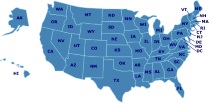Map & Globe Skills
The ability to properly read maps and globes gives you an opportunity to explore different places, people, and cultures in the real world. These resources, teaching tips, and ideas will help make it easy for your children to learn to read and understand maps and globes.
Activities & Experiments
Great States Board Game
What is the capital of NJ? Where is the Football Hall of Fame? These are just a few of the hundreds of questions players are asked as they adventure around the USA discovering state attractions and landmarks, capitals, state abbreviations, state locations and more. In order to answer the questions on the cards, players must look closely at the colorful USA map game board, becoming familiar with the geography of the country. Players must hurry to find the answers as the mechanical timer ticks. Contents: Game board, 100 Figure cards, 100 Fact cards, 100 Find cards, 1 spinner, 1 mechanical timer, and game rules. Duration of Play: 20 minutes. 2-6 players.
Postcard Kids
Geography Postcard Kids Project started for homeschooled children around the world in October of 2002. It is intended to help enhance geographic studies by sending postcards from their local area to other postcard kids around the world.
Name That Country Game
"Dear Pen Pal, Konnichi wa! We've been to see Mt. Fuji. Name my country! Sayonara, Michiko." Challenge your group with this fast-paced geography game, created in 1992 by Educational Insights, Inc. Everyone begins at the post office. Players twirl a finely printed spinner (built into the game board itself) to select one of 60 countries. If the player can correctly identify the country's location on the board's numbered map, he or she may advance along the path to the finish. Bonus moves are won by landing on "postcard" spaces, listening to the clues on one of the 40 postcards, and correctly identifying the pen pal's country. (The sample postcard above came from Japan.) A more challenging game can be achieved by requiring players to name the country's capital; answers are provided. --Liane Thomas
Teaching Tips & Ideas
How I Teach a Large Family in a Relaxed, Classical Way: History
A look at teaching history across several grades using the classical method of education and a rotation of history every four years.
Knowledge Quest
Knowledge Quest offers historical outline maps and timelines designed for the interactive study of world history and geography.
Featured Resources
As an Amazon Associate, we earn from qualifying purchases. We get commissions for purchases made through links on this site.
Homeschooling: The Teen Years : Your Complete Guide to Successfully Homeschooling the 13- to 18- Year-Old (Prima Home Learning Library)
The teen years are when many homeschooling parents start to question or abandon their efforts. It's a precarious time, with challenging academics, pressing social issues, and the prospect of college looming. Parents can now breathe easy: this guide calms the teen-time jitters and even offers hope to those just turning to homeschooling now that their child is about to enter high school. With brief "how we did it" testimonies from other parents sprinkled throughout the book, author Cafi Cohen offe...
The Mystery of History
The Mystery of History series is another alternative to traditional textbooks. The five volume set covers history from creation to present day, with a biblical worldview. This series is intended for grades K-8. Note that at this time, this series is not completed.
Catholic Homeschool Companion
Here’s your one-stop resource for information, insight, and inspiration about every aspect of educating your children at home — written by those who understand it best: homeschooling parents themselves! Would you like to teach science or phonics better? Introduce your child to Latin, piano, or great works of art? Try new classroom approaches that other parents find effective? In these pages, you’ll find helpful essays from more than forty veteran homeschooling parents to help you do all this and...
The Well-Trained Mind: A Guide to Classical Education at Home
This book will instruct you, step by step, on how to give your child an academically rigorous, comprehensive education from preschool through high school. Two veteran home educators outline the classical pattern of education—the trivium—which organizes learning around the maturing capacity of the child's mind: the elementary school "grammar stage," the middle school "logic stage," and the high school "rhetoric stage." Using the trivium as your model, you'll be able to instruct your child in all ...
Unclutter Your Home: 7 Simple Steps, 700 Tips & Ideas (Simplicity Series)
Hundreds of practical ideas for sorting, evaluating, and getting rid of all those material items that get in the way of a simplified lifestyle.






